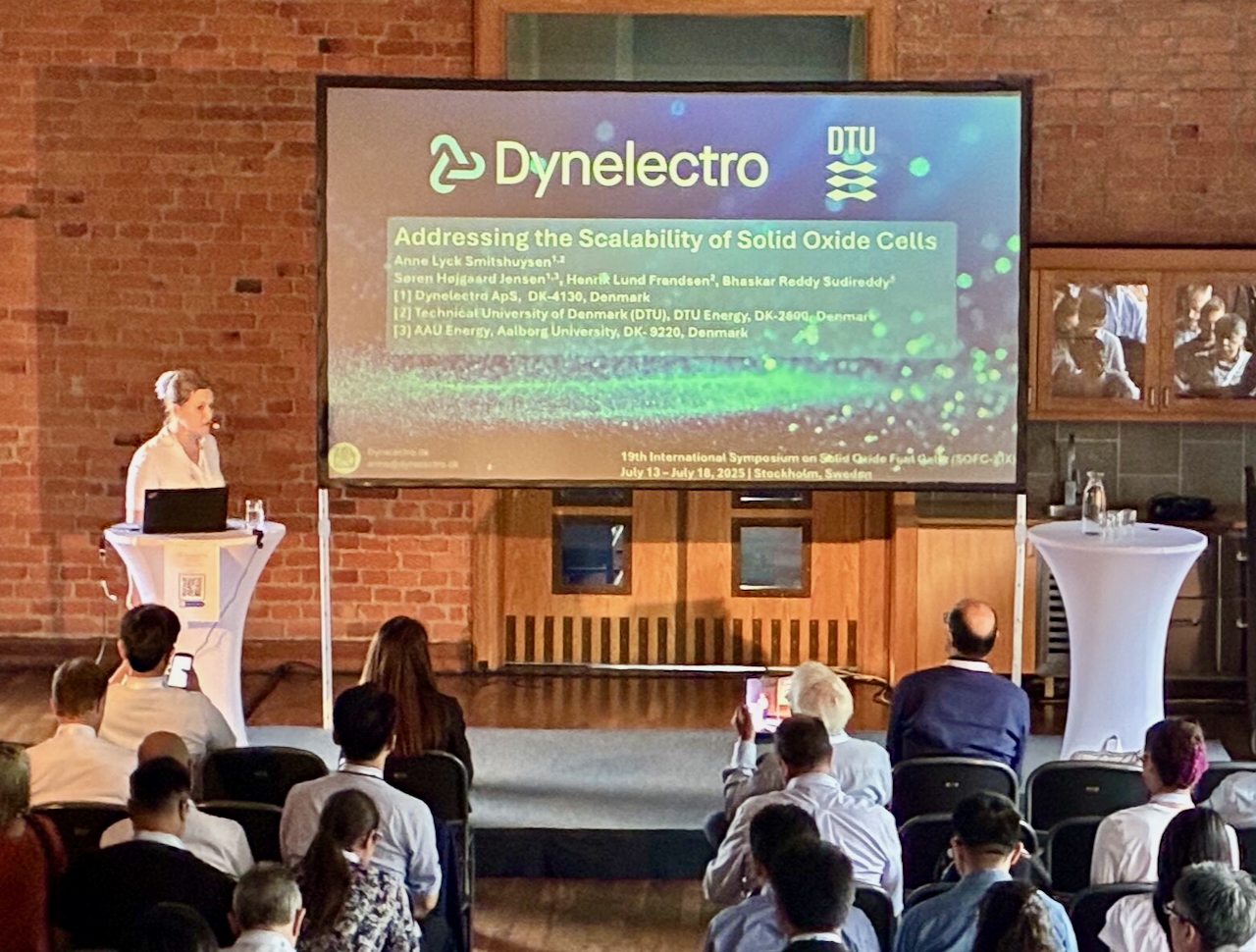Advancing the Frontiers of Solid Oxide Cell Technology
July 8, 2025

Advancing the Frontiers of Solid Oxide Cell Technology
At Dynelectro, we actively contribute to the global research community driving the transition toward sustainable, high-temperature electrolysis. Our recent collaborations and scientific presentations highlight new insights into durability, scalability, and feedstock flexibility in solid oxide electrolysis (SOEC) and co-electrolysis systems.
Thomas Erik Lyck Smitshuysen – The Necessity of AC:DC for Long-Term Operation
20,000 hours of operation on a 70-cell SOEC stack
Thomas Erik Lyck Smitshuysen’s work demonstrates a major leap in SOEC longevity through alternating AC/DC operation. By switching between electrolysis and fuel-cell modes several times per second, the system achieves a stable thermal balance and drastically reduces degradation. This breakthrough marks one of the longest continuous SOEC operations to date—20,000 hours—and underscores Dynelectro’s unique AC:DC approach to sustainable hydrogen production.
Ana García Romañach – Carbon Deposition on Solid Oxide Electrolyser Cells
From CO₂ electrolysis to co-electrolysis
Ana García Romañach explores the mechanisms of carbon deposition in Ni-YSZ electrodes during CO₂ and co-electrolysis. Her findings emphasize how fine-tuning gas composition and operating conditions prevents carbon nano-fiber formation—ensuring electrode integrity and performance stability. This work deepens understanding of how to maintain catalyst activity and extend SOEC lifespan under high-conversion, carbon-rich conditions.
Federico Mattera – Biogas-Operated SOCs for Enhanced Syngas Production
Experimental investigation of short-term degradation
Federico Mattera’s research investigates co-electrolysis under biogas feedstock conditions, uncovering new pathways for efficient syngas production. His experiments reveal the short-term degradation behavior of biogas-operated solid oxide cells and identify operating parameters that balance conversion efficiency with cell durability. This research supports Dynelectro’s ambition to enable feedstock-flexible, renewable syngas systems.
Anne Lyck Smitshuysen – Addressing the Scalability of Solid Oxide Cells
From laboratory innovation to industrial impact
Anne Lyck Smitshuysen focuses on the challenges of scaling solid oxide technology from lab-scale cells to full-size stacks. Her research emphasizes material design, manufacturing precision, and structural robustness as critical factors for reliable, large-scale deployment. By bridging scientific discovery and industrial engineering, Anne’s work brings SOEC technology closer to commercial readiness.

Presentation at SOFC-XIX by Anne Lyck Smitshuysen
Expanding the Scientific Foundations of Dynamic Electrolysis
In addition to Dynelectro’s four featured presentations, two leading research institutions have published complementary studies building upon our collaborative work in solid oxide and proton-conducting electrolysis. These projects highlight the growing academic engagement with Dynelectro’s AC:DC operation principle and advanced electrode engineering.
Aalborg University (AAU) – Investigation of Frequency Effects in AC:DC Dynamic Operation on SOECs
Researchers at Aalborg University have examined how electrical frequency impacts the performance and degradation rates of solid oxide electrolysis cells under dynamic AC:DC operation. Their findings confirm that frequency modulation directly influences gas distribution, heat uniformity and electrochemical stability further validating Dynelectro’s pioneering approach to extending SOEC lifetime through controlled alternating operation.
Technical University of Denmark (DTU) – Optimizing Ni/BCZYYb7111 Fuel Electrode Microstructure in Proton Conducting Cells
At DTU, researchers have focused on refining the Ni/BCZYYb7111 fuel electrode microstructure in proton-conducting cells, a material system with promising efficiency and durability benefits. Their work demonstrates how microstructural tailoring, through sintering control and porosity optimization, can significantly enhance current density and thermal compatibility. These insights directly support Dynelectro’s efforts to push the frontiers of next-generation high-performance electrolysis.
 Dynelectro Team picture from the SOFC-XIX conference summer 2025
Dynelectro Team picture from the SOFC-XIX conference summer 2025
From left to right: Federico Mattera, Thomas Lyck, Anne Lyck and Ana Romañach